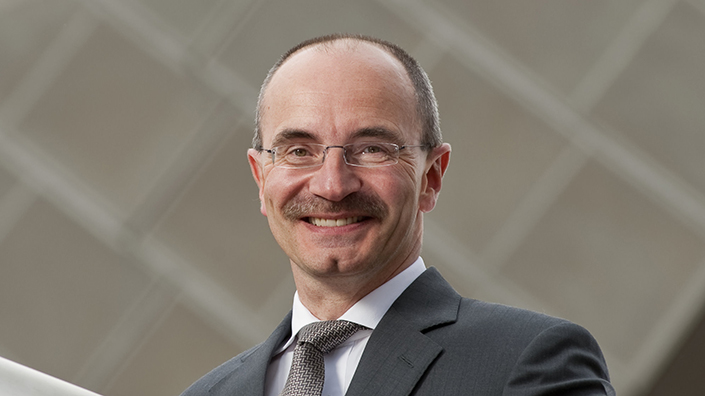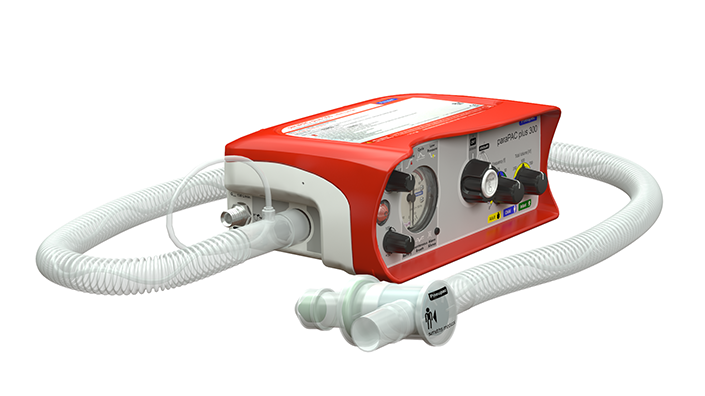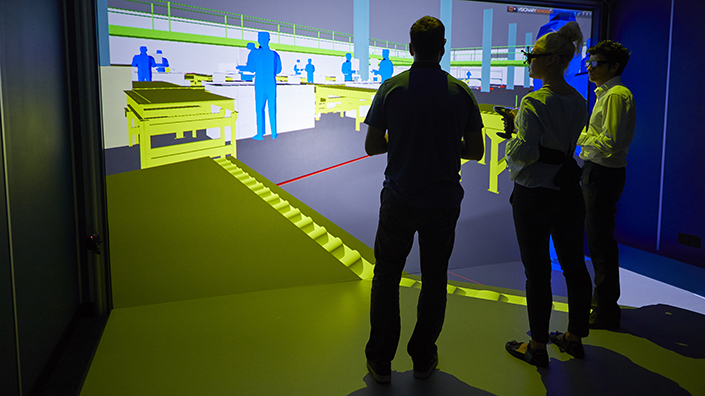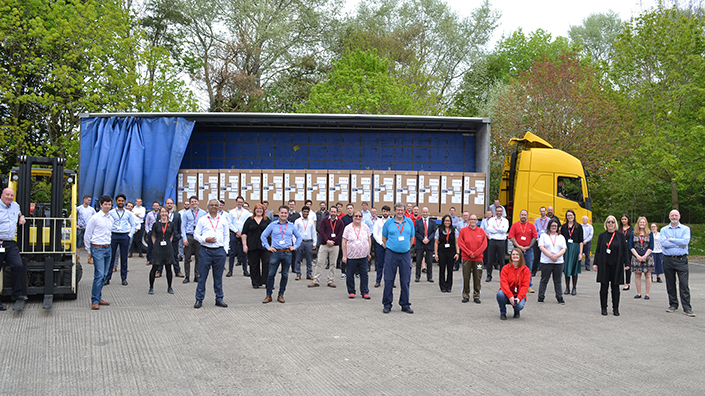Dick Elsy, chief executive of the High Value Manufacturing Catapult (HVMC), was looking forward to his retirement in August. “I am having slightly mixed feelings about moving on, because we are moving into a fascinating period of change here, where we have got huge societal and environmental challenges coming up,” he told Professional Engineering at the time. He stressed the importance of the Catapult’s “independent stewardship”, and took pride in developing it to become the biggest manufacturing institute in Europe.
Exactly one week later Elsy was on the phone with Michael Gove, minister for the Cabinet Office, and about 100 other industry experts. There were now 1,543 confirmed cases in the UK, and 65 people had died. Earlier that day, Prime Minister Boris Johnson had called on manufacturers to build “as many new ventilators as possible”. The country had 5,000 already, but the government said many more were needed to help the NHS save lives.
Elsy’s retirement was on hold.
Consortium comes together
On the call, officials shared the ventilator specification before Gove opened up the floor. “He said: ‘Right, OK, over to you industry. Any questions?’,” remembers Elsy.
There was a long, vacuum-like silence. “I could hear the cogs whirring in people’s minds, that they wanted to do something. But how on Earth do we put all this together?”

Dick Elsy put his retirement on hold to lead the challenge
Elsy stepped in. “I think there’s a role for the HVMC here, to bring some interested parties together,” he said. “So I kind of made a commitment to then form the principles of a group of people, or a group of companies, that might want to get together to work in a consortium.”
That was the start of the Ventilator Challenge UK, the nation’s most ambitious collaborative engineering project since the Second World War. Aerospace manufacturers, Formula One teams, digital experts and many others came together, aiming to build 20,000 ventilators.
The Cabinet Office had worked with clinicians and the Medicines and Healthcare Products Regulatory Agency to put together the specification for the Rapidly Manufactured Ventilator Systems (RMVS), including details of desired ventilation modes, pressure settings and respiratory rates. Other requirements included impermeable casing, in-built alarms, continuous operation for more than 14 days, and ease of training for use.
Elsy immediately started calling people he thought might be interested in the project, and were willing to take a corporate and personal risk. Partners including Microsoft, PTC and McLaren started conversations and the group joined forces with a small aerospace consortium formed around Meggitt. The team immediately decided that the quickest way to meet the RMVS specification was to back an existing ventilator design and scale up production, rather than starting with a blank sheet of paper – other firms, such as Dyson, took that approach but ultimately cancelled projects owing to lengthy approval times and lower-than-expected demand.
The ideal candidate
Before the pandemic, the only company building ventilators in the UK was Smiths. The Parapac Plus had been tried and tested in the NHS for 10 years, with a relatively small number built every week at Smiths Medical’s factory in Luton.
The Parapac was ideally suited thanks to its lightweight, feature-rich and transportable design, says Chris Percival, Smiths chief of operations. It can be used during MRI scans, has an internal long-life battery for redundancy, and is designed with fast and intuitive training in mind.

Before the pandemic, the only company building ventilators – such as the Parapac Plus – in the UK was Smiths
The firm had started contingency planning as the coronavirus first made international headlines. By January, it was sourcing extra materials and planning to train new manufacturing staff. It also did a report on safe working practices during the pandemic for its sites in Asia – in other words, it was an ideal fit for the consortium. The challenge started working with Smiths straight away, with the company leading that ‘strand’ of the project.
Full-fat or semi-skimmed?
On Friday 20 March, the Cabinet Office asked Elsy and his colleagues to investigate another option. Penlon, a 75-year-old spin-off from Oxford University, had said it could “comfortably” meet the high end of the specification by reconfiguring subsystems contained within its anaesthesia machine.
A team was despatched to investigate the next day, and given 24 hours to learn as much as possible about the production process and materials involved. “We could only really see what I would call the full-fat version of the product being built,” says Matt Byrom, business excellence consultant at Siemens. “We were going to build a semi-skimmed version.”
Penlon also made what chief executive Guru Krishnamoorthy calls a “loosely put together prototype”. The consortium team investigated the systems, electronics, and options for the supply chain and production ramp-up. There was a call at the end of the day, and the challenge agreed to get behind it on the spot. The hard work was about to begin.
-copy.jpg?sfvrsn=ed79c12_0)
Penlon adapted existing subsystems to create its ventilators
With the designs selected and a government order in place – 15,000 Penlon devices and 5,000 Smiths Parapacs – McLaren took an overarching position on procurement and started sourcing materials and parts for the Penlon strand. The focus switched to how and where the ventilators would be built.
In a stroke of good fortune, Airbus had an ideal – and timely – answer. “I was already aware of this new AMRC facility which had been opened in Broughton at the middle of February, and was 10 days away from Airbus putting their new Wing of Tomorrow [programme] in. If they had already put that in… that would have been a non-starter, because it would have taken millions of pounds [to refit],” says Andrew Peters, managing director at Siemens Digital Factory in Congleton, Cheshire.
Siemens used its NX Line Designer to create a digital twin of a factory floor for the Broughton facility, using it to simulate the required production on a socially-distant one-way system. The team then converted the digital twin to a real-life factory, with eight production lines for the ventilators’ absorbers and eight for the flow meters. Siemens used standard manufacturing solutions, fitting everything into half the AMRC’s footprint.
Network of sites
Elsewhere, Ford used a site in Dagenham for assembly. GKN and Rolls-Royce offered locations in Luton, Gloucestershire and the Isle of Wight for the Smiths device, with numerous other firms working around the country. The Broughton and Dagenham facilities were equipped within about a month.
Such a spread-out project meant a huge logistics challenge. The consortium had sourced 11m parts within the first month, all requiring sorting and distribution by DHL. Surface Technology International in Hampshire combined ventilator sub-assemblies before final testing at Penlon and elsewhere.
Poka yoke
Setting up new factories and a giant supply chain was almost straightforward compared to the consortium’s other giant challenge – training the hundreds of people required for the massive increase in production. In the old normal that would have involved assembly operators, engineers and technicians in a classroom with training materials. During the pandemic, that option was off the table.
Instead, the consortium embraced digital technology. Augmented reality (AR) technology, in particular the Microsoft Hololens, played a big part in collecting expert knowledge and packaging it in an accessible way for knowledge transfer.

New digital technology, such as Siemens' NX Line Designer, was vital to the project's success
Teams visited pre-existing manufacturing sites, using the Hololens to film over-the-shoulder videos of production and cutting it into steps using PTC’s voice-controlled Vuforia software. Production line staff could then watch it, either on tablets or on Hololens headsets.
The digital process prevented disease transmission but also made training much more efficient, says Alex Woolner, AR sales engineer at PTC. Expert knowledge was collected quicker than ever before, and could be digested easier than old-fashioned print-outs thanks to a reduction in ‘cognitive distance’ between the trainee and the information.
Straightforward software editing of training techniques also allowed Siemens to optimise production, says Byrom, altering or reordering steps and maximising the poka yoke – a Japanese term meaning ‘mistake-proofing’, through preventing the opportunities for mistakes to be made. The company also quantified some measurements and processes to ensure that veteran manufacturers’ knowledge could be safely replicated. ‘Hand tight’ became 1,000Nm, for example.
The F1 mindset
The strength of the Penlon machine was also one of its weaknesses. The anaesthesia machine’s absorber, flow meters, computing architecture, several pneumatic parts and electronics were reused in the new ventilator. This practically ensured regulatory approval, but not all parts were readily available in the volume needed. One chipset in particular was out of production, threatening to derail the project. “I was thinking, ‘this could disable the programme’,” says Elsy.
Within 24 hours, McLaren had persuaded a manufacturer in Israel to build the previously obsolete parts from scratch, in a much higher volume than ever before.
The Formula One mindset was key to McLaren’s approach, says Mark Mathieson, lead partner in technology services. “We just have to get stuff done,” he says. “On Sunday afternoon you can’t not be on the grid. So you can’t delay anything, you’ve just got to get it done.”
The next challenge?
Production increased rapidly, and by late May the Airbus facility in Broughton was producing 400 units a day. Thankfully, the worst-case scenario with the coronavirus was avoided but many lives were saved and the challenge has a rich legacy.
“That awful scenario of insufficient ventilator capacity, and people queuing outside the hospitals, fortunately didn’t take place,” says Elsy. “So we are building for resilience… which is a great place to be.”

The first shipment of ventilators leaves Penlon
Members of the consortium are “determined” not to forget the lessons learned, he says. Principles included empowering people to make the right decisions and self-organisation of teams.
“Moving on to zero-carbon by 2050 – it’s no less of an emergency,” says Elsy. “Our determination is to use some of the experience we’ve had to get behind big programmes like that.” Across the consortium, members expressed the same desire to maximise the long-term benefits of the project. “Wouldn’t it be great if the way that this consortium is operated could be applied to things like climate change,” says Byrom. “Everything’s been open book, shared purpose, shared goal. And we’ve all been pulling in the same direction.”
The project was a landmark moment for UK engineering, and its influence will last for many decades. “The last time that GKN, Rolls-Royce and Smiths worked on a collaborative project was in the 1940s when they produced the Spitfire aircraft,” says Percival at Smiths.
The intense and fast-moving project has been “life-changing” for everyone involved, says Elsy. “The ‘can do’ spirit has been extraordinary… this is a classic case of engineers getting together and collaborating around a large challenge.” He is still planning to retire, but won’t be leaving until next year at the earliest. In the meantime, industry needs a hand getting back on its feet – it looks like another job for Elsy and the HVMC.
This article appeared in Professional Engineering Issue 5, 2020.
Want the best engineering stories delivered straight to your inbox? The Professional Engineering newsletter gives you vital updates on the most cutting-edge engineering and exciting new job opportunities. To sign up, click here.
Content published by Professional Engineering does not necessarily represent the views of the Institution of Mechanical Engineers.